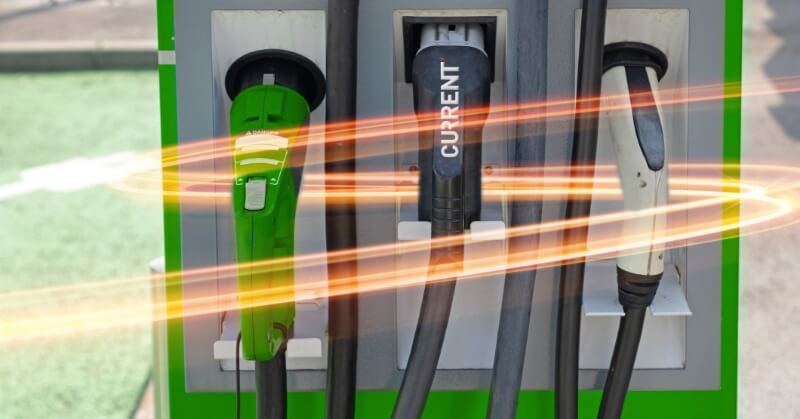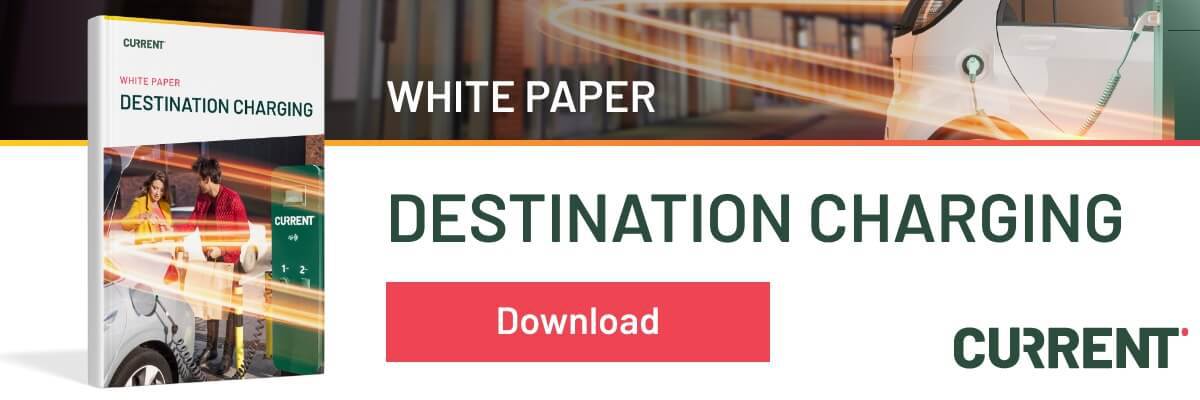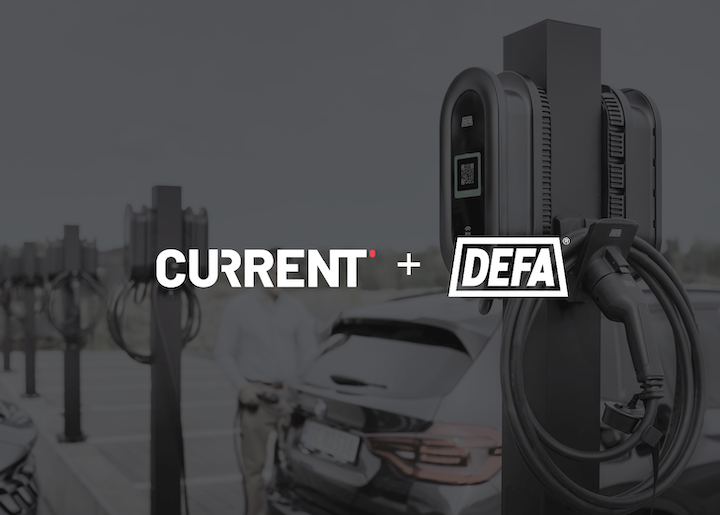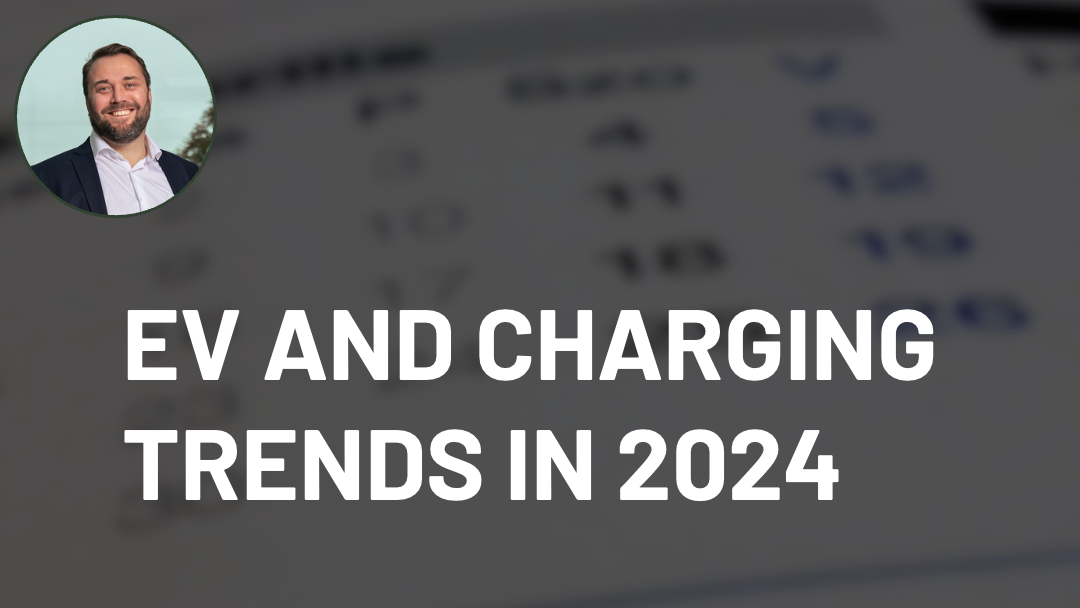
Destination charging (also known as AC charging) is a fantastic way to get people to spend more time at a business or other destination. This is the kind of charging that’s ideal for shopping centers, hotels, restaurants, and anywhere else drivers will be staying for longer than an hour and don’t want to have to rush.
While the DC fast charging network allows people to top up quickly and be on their way, making these chargers perfect for places like service stations and supermarkets, slower AC charging allows drivers to leave their EV plugged in without having to worry about rushing back to it.
The question is, when it comes to destination charging, what’s the right solution for you? CURRENT is here to answer your frequently asked questions on this exciting topic.
Understanding the hardware
When considering an electric vehicle charge point for your business, there are some things you need to consider when it comes to selecting the right devices.
The Type of Charger That’s Right for Your Customers
Destination chargers charge at slower speeds than DC chargers. When drivers are looking for an experience that’s closer to what internal combustion engine (ICE) drivers have when refueling – doing so in the shortest possible amount of time – DC is the right option. That’s the kind of charger you’ll find at service stations and short-stay car parks.
However, there are many times and places where AC is more appropriate and convenient. When drivers need to park for several hours and want to be able to charge without worrying about taking up space someone else could use, slower AC charging is ideal. It allows them to visit loved ones, stay somewhere overnight, go to the cinema or a theme park, and then return to a charged vehicle. It also has the added benefit of reducing pressure on the DC charging network, and means fewer stops for fast charges between destinations.
The Connectivity of Your Chargers
Smart charging gives you connectivity options that can make the user experience more straightforward, improve maintenance and customer service, give you deeper insight into your chargers, and allows you to control when power is actually entering the vehicle, allowing you to use it in the most effective way.
The ability to choose when power flows into the EV means you reduce stress on the grid by ensuring charging doesn’t happen during peak times. If you want full control over your power use, a smart charger is vital.
Look for OCPP Compliant Chargers
The Open Charge Point Protocol (OCPP) is the gateway to a better, more mutually beneficial smart charging ecosystem. It’s an open-source communication standard for charging stations, charge point management systems, and EVs themselves. Because it’s an open protocol, adding new features and improvements is easy, as well as standardizing the system.
Right now, OCPP provides support for:
- Real-time remote charging station monitoring
- Bespoke security and authentication
- Dynamic load management to better utilize energy
- Remote firmware updates
CURRENT’s own software strictly follows the OCPP protocol, meaning it’s also fully certified by the Open Charge Alliance, allowing us to integrate with over 40 charging hardware brands.
If you choose a charger that isn’t OCCP compliant, you could limit yourself to the software and connectivity options you’re able to implement later on.
Choosing the Right Charger for Your Business
Once you’ve thought about the needs of your customers and the hardware that will best serve them, you need to think about the practicalities of those chargers.
Considerations for Installation
There are several things to take into account when it comes to installation, including:- The space available for chargers - Consider how many you can fit in and how your customers might use them.
- The electrical infrastructure and ability for power to flow - Do you already have access to enough electricity to serve these chargers? If not, you’ll need to think about how you might manage this.
- Accessibility and visibility of chargers - Take both accessibility and safety into consideration. Will people with disabilities be able to access your chargers and are they in a safe, well-lit spot?
Every location is different so it’s worth speaking to an expert if you’re unsure what might suit the proposed site of your destination chargers.
Think About Dwell Time
How long are drivers likely to stay at your car park? When it comes to destination charging, this is a vital consideration. Typical locations that are suited to destination charging include:
- Shopping centers
- Hotels
- Theme parks
- Cinemas
- Theaters
- Retail parks
Cinema-goers are likely to be charging for at least three hours, while someone staying overnight at a hotel might be there for 16 hours. Either way, even a 7 kW AC charger can likely offer drivers what they need to get them on their way, and if not, there’s every chance they will extend their visit to charge fully.
How Many Chargers Do You Need?
The number of chargers you need will be based on:
- The expected number of EV visitors, and;
- The needs of the driver, i.e. whether they need a fast or slow charge
You might want to include a DC fast charger for short stays requiring quick charging, but the majority of your chargers should be AC if you want to reap the benefits of destination charging.
If you’d like some advice on what might work for your business, get in touch with CURRENT today.
Frequently Asked Questions
What charger should I install?
To make the most of destination charging and to increase customer dwell time, AC chargers that are OCPP-compliant with smart charging software are the best choice.
How many chargers do I need to install?
The number of chargers you need to install depends on the type of location and size of the car park, but you’ll want to focus primarily on AC chargers if your customers tend to spend a lot of time at your location.
What funding options are available?
There are a variety of funding options depending on territory. In Norway, a grant scheme has been launched to support the installation of charging stations for electric trucks and buses in Oslo, for example. CURRENT can help you figure out exactly which schemes you can take advantage of.
What are the electrical requirements for EV chargers?
This varies depending on the electrical infrastructure already in place on-site and the types of chargers you’re installing. Typically, AC chargers require less infrastructure work and are quicker to install. DC chargers, on the other hand, are more complex to install and require specific infrastructure work. Either way, you must be compliant with all regulations that affect your charging plaza.
CURRENT always conducts a site survey to help you better understand exactly what is possible with the infrastructure you already have in place and what extra work might need to be done.
What is the installation process like and how long will it take?
Following the site survey, our customers can expect the installation of AC chargers to take anywhere from three to seven days. Before we begin, we’ll share a full timeline and schedule of work so you’ll know exactly what to expect.
A typical project usually looks like this:
- Asses the site (1-2 days)
- Project the charging infrastructure (3-4 days)
- Install the charging infrastructure (from one day)
- Invite the users (30 min)
What is involved in the maintenance and upkeep of EV chargers?
We can support you when it comes to maintenance and upkeep. The suggested maintenance schedule will vary depending on the types of chargers you install and how often they are used.
In order to guide our customers, we automatically configure charge points according to the installation environment, based on information provided by the CPI (charge point installer). Once the charger is connected and auto-configured, CURRENT is able to maintain the connections through auto-heal functionality and continuous improvement of the charge point integrations. The major benefit of this is that business owners can focus on other day-to-day tasks while we take on the brunt of managing the chargers.
How can I measure the success of my chargers?
In order to help you track charger activity against your goals, we provide an analytics dashboard to give you deeper insight into income, energy use, and more. We can support you on setting which metrics to measure and how these might align with your wider business objectives.
As the use of EVs becomes more widespread, destination charging will soon become something that makes or breaks a business or site’s lasting appeal. Most people prioritize convenience, and as the world adjusts to a different way of driving, the ability to park and leave an EV to charge slowly without having to think about it will become all the more important.
When considering destination charger, remember to think about:
- The available space and infrastructure you already have
- Compliance
- Future-proof technology
- The amount of time EV drivers are likely to want to spend charging
- The funding available to you
On all of these points, CURRENT can guide you to make the best decisions for your business. Get in touch with the experts today.




